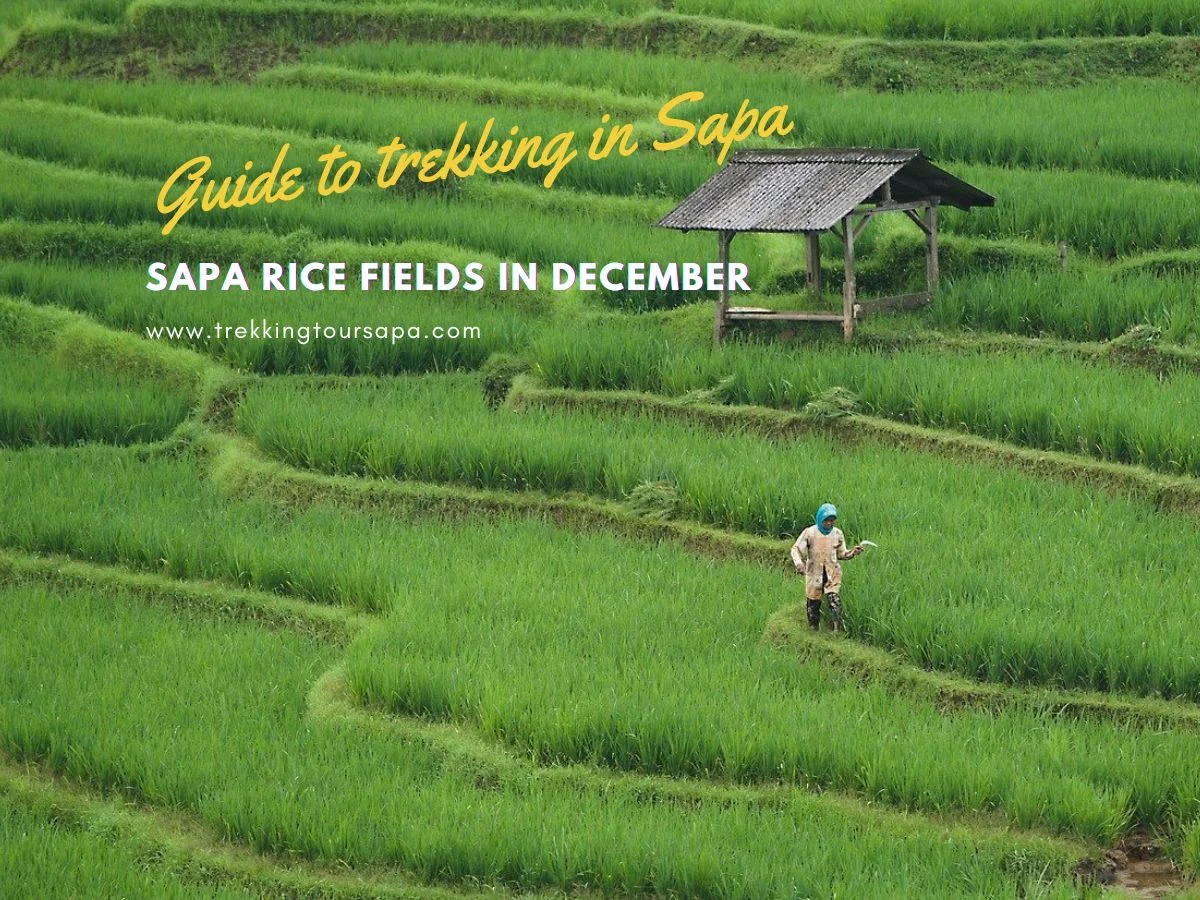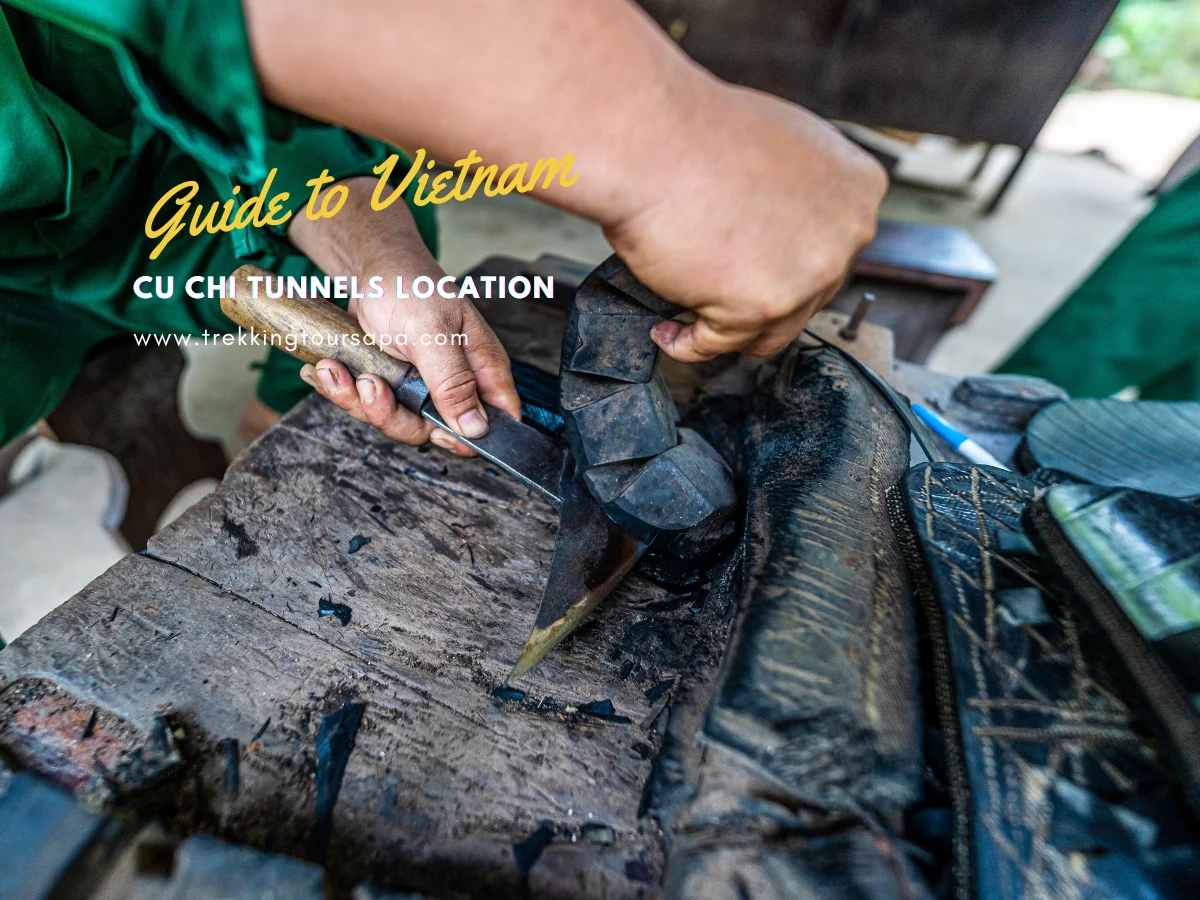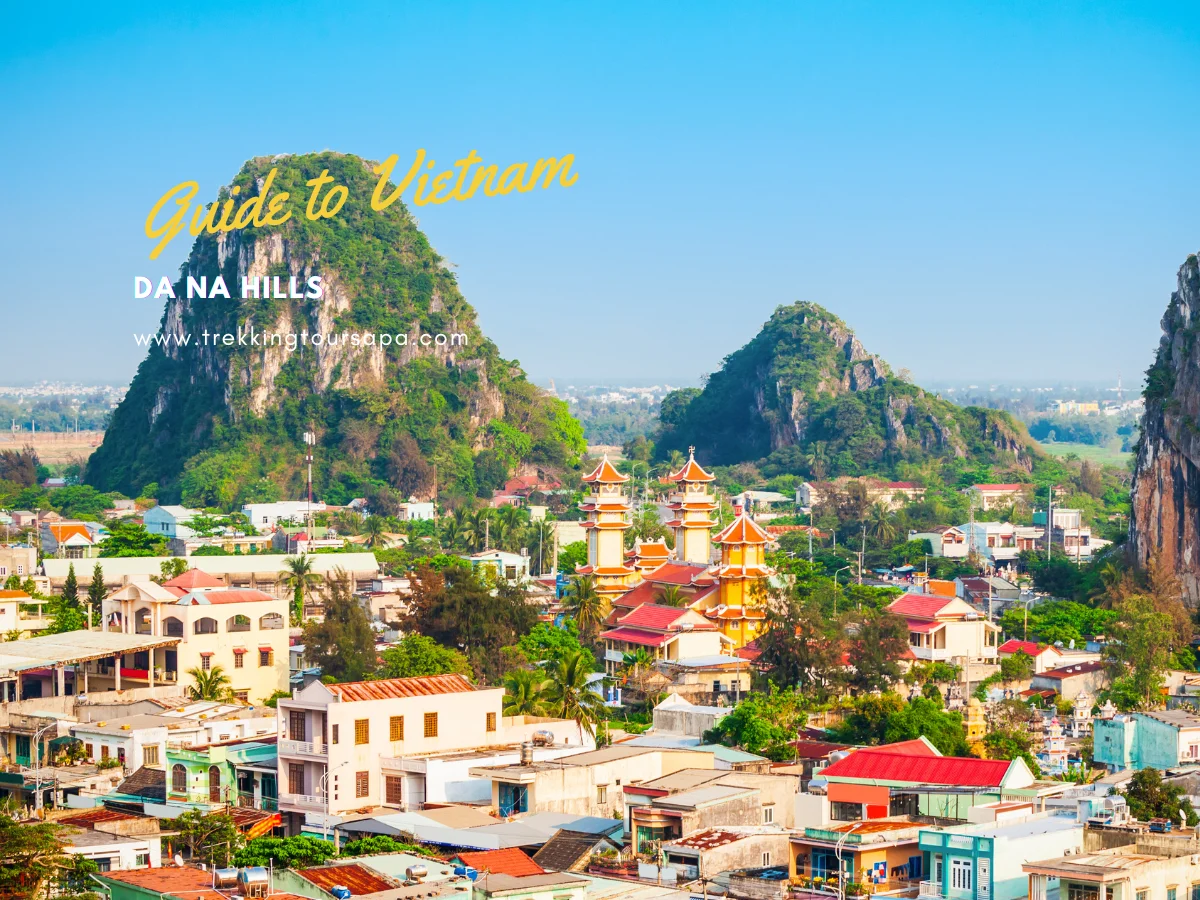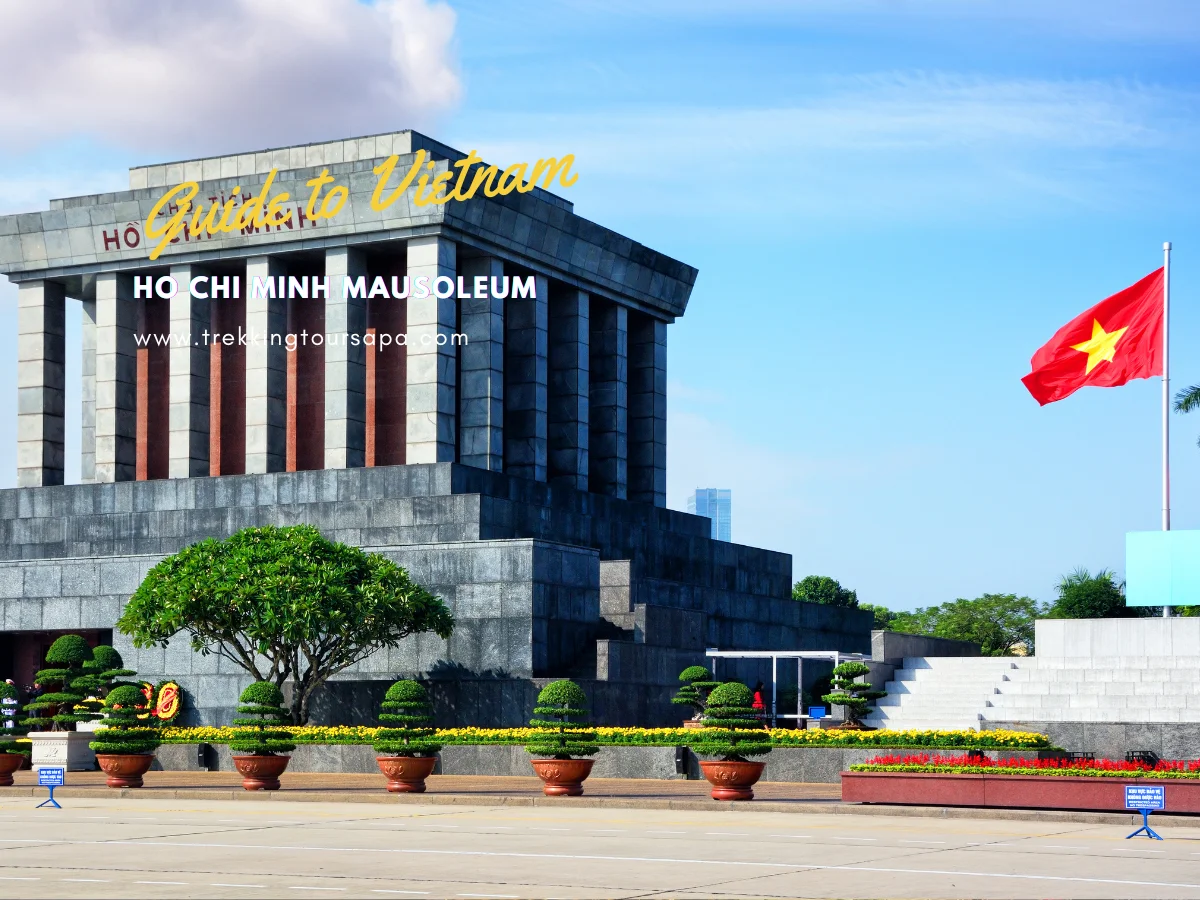You’re looking for an escape, a chance to break free from the daily grind and immerse yourself in something new. What better way to do that than by visiting the Sapa rice fields in December? These majestic terraced fields, located in northern Vietnam, offer a stunning vista of greenery and natural beauty that will leave you breathless.

As you walk through the rice fields, you’ll be transported to another world – one where time seems to slow down and worries fade away. The gentle sound of rustling leaves and flowing water will soothe your soul as you take in the stunning scenery around you. But there’s more to these rice fields than just their aesthetic value; they represent centuries of tradition and hard work by the Hmong people who have cultivated them for generations. In this article, we’ll explore everything you need to know about the Sapa rice fields in December – from how to get there and what to expect when you arrive, to tips for making the most of your visit. So let’s dive in!
Table of Contents
ToggleLocation and Description of Sapa Rice Fields
Here’s where you’ll find the stunning green landscapes that have been shaped and cultivated by generations of farmers in this mountainous region. The Sapa rice fields are located in northern Vietnam, about 350 km from Hanoi. These terraced rice paddies stretch out for miles, creating a breathtaking view of scenic beauty that should not be missed.

Aside from its picturesque landscape, the Sapa Rice Fields hold great cultural significance to the people of Vietnam. For centuries, rice cultivation has been an important part of Vietnamese culture and tradition. It is even believed that the first Vietnamese civilization was developed around rice farming. As you explore these fields, you’ll begin to understand just how vital this crop is to the country’s economy and way of life.
The Importance of Rice Cultivation in Vietnam
You can imagine the lifeblood of Vietnam flowing through its rice paddies, as this humble grain has sustained and shaped the country’s culture for centuries. Rice cultivation is deeply ingrained in Vietnamese society, and it plays a pivotal role in their daily lives. The rice culture here is not just about eating; it also reflects the spiritual beliefs, social practices, and agricultural techniques of the people.
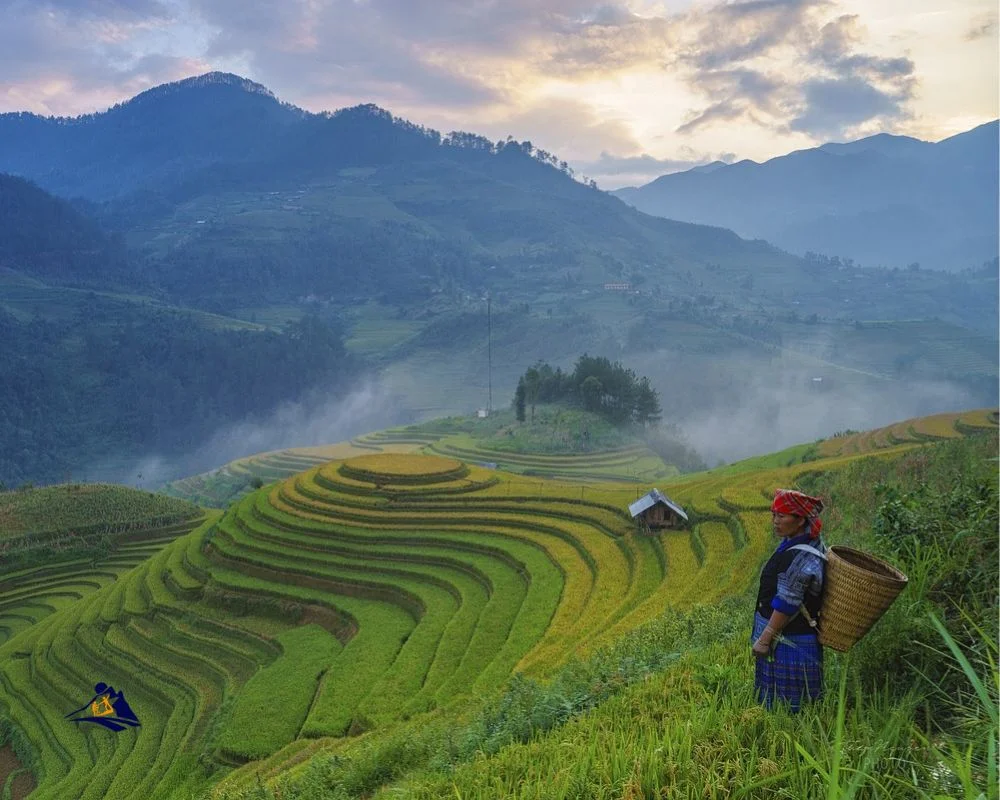
To illustrate this point, consider these two nested bullet points:
- Rice farming has had a significant economic impact on Vietnam. It accounts for more than 20% of the country’s GDP and employs nearly half of its population.
- With such extensive reliance on rice farming, any changes in production or prices can have far-reaching consequences for both rural and urban areas.
- Beyond economics, rice cultivation also serves as a symbol of national identity. In Vietnamese folklore and literature, rice represents hard work, resilience, communal harmony, and even love.
With this understanding of how vital rice farming is to Vietnam’s past and present, let us now turn our attention to Sapa’s Hmong people and their traditional farming practices.
The Hmong People and Their Traditional Farming Practices
As the misty mountains of northern Vietnam slowly come into view, you can’t help but marvel at the sheer beauty of the Hmong people’s traditional farming practices. The Hmong, one of Vietnam’s ethnic minority groups, have been farming these hills for centuries using techniques passed down from generation to generation. Their methods are infused with cultural significance and respect for nature, making it a truly unique experience to witness.
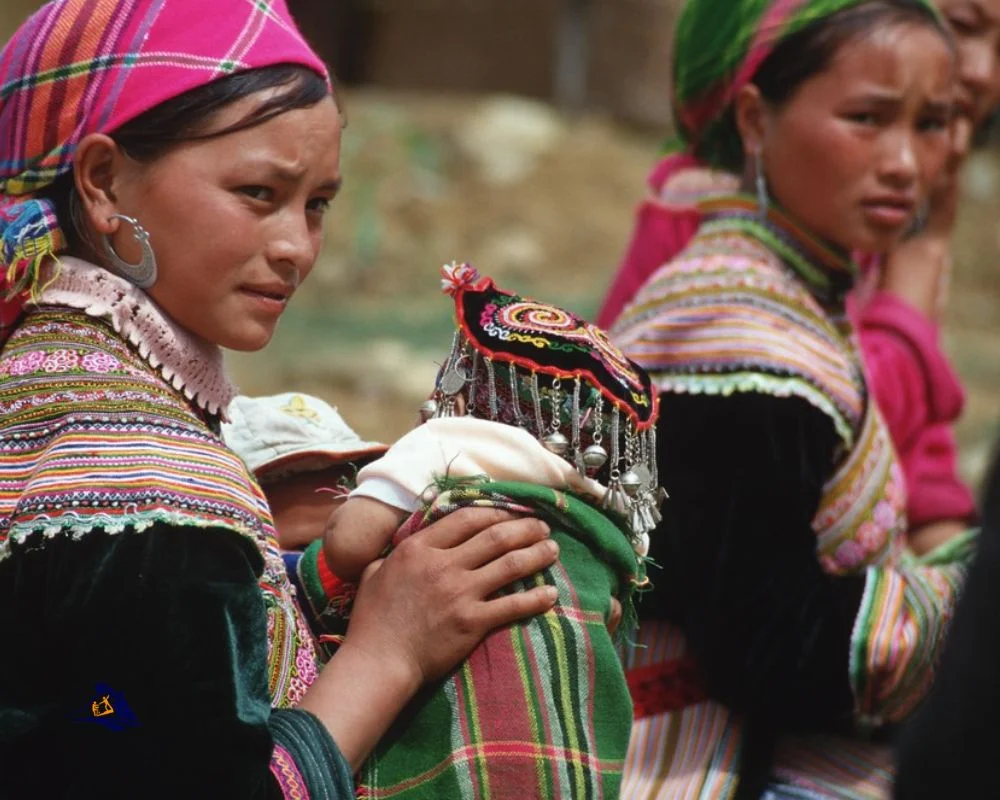
Their traditional techniques involve planting rice on steep terraced fields that follow the contours of the mountain slopes. They use natural fertilizers and pesticides made from local ingredients and hand plows their fields with oxen or water buffalo. This method not only produces high-quality rice but also preserves the environment by preventing soil erosion. Witnessing such an eco-friendly agricultural process is truly remarkable and gives you a deeper appreciation for sustainable living.
With such a rich culture and breathtaking scenery, Sapa rice fields in December should be on your travel bucket list. You’ll get to see firsthand how the Hmong people live off their land while soaking in some of Vietnam’s most stunning landscapes during harvest season. So pack your bags and prepare yourself for an adventure like no other!
Sapa 1 Day Tours
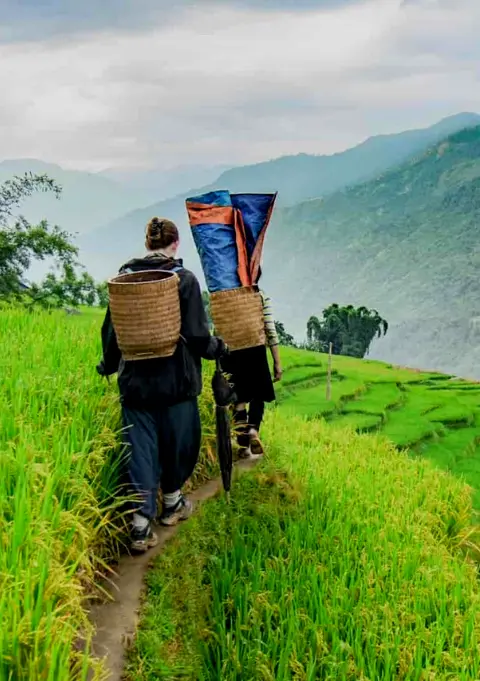
- 1 day experience
- Moderate to challenging
- Cultural immersion & active adventure
- Rice fields, valleys & villages
- Private tours
- Vegan-friendly
Sapa 2 Day Tours
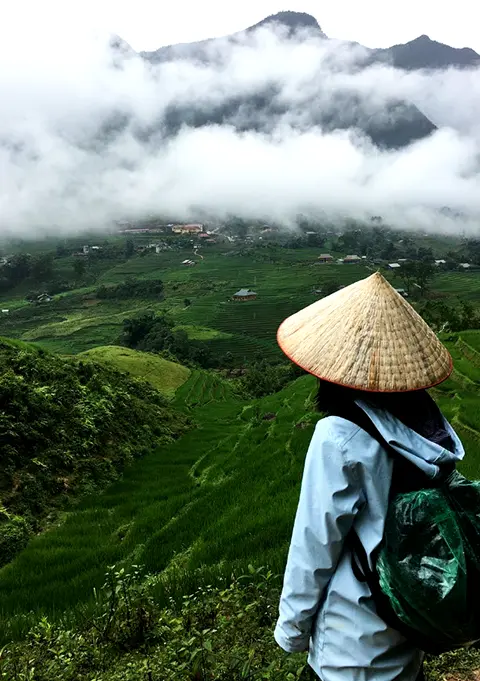
- 2 days 1 night experience
- Moderate to challenging
- Cultural immersion & active adventure
- Mountains, valleys, rice fields and villages
- Private tours
- Vegan-friendly
Sapa 3 Day Tours
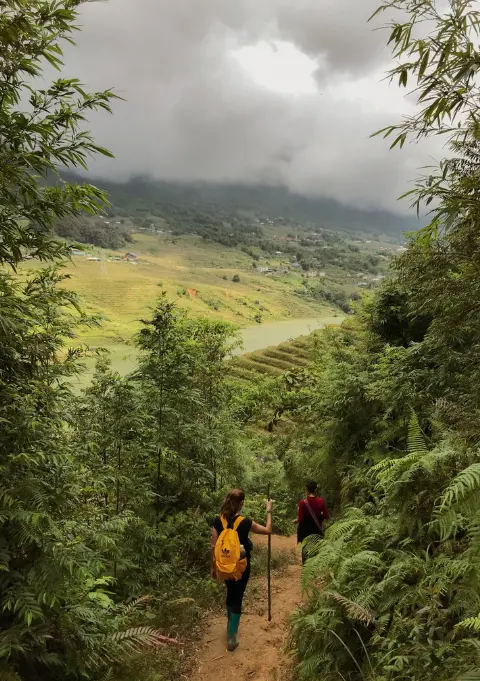
- 3 days 2 night experience
- Moderate to challenging
- Cultural immersion & active adventure
- Mountains, valley, rice fields & villages
- Private tours
- Vegan-friendly
Sapa 4 Day Tours
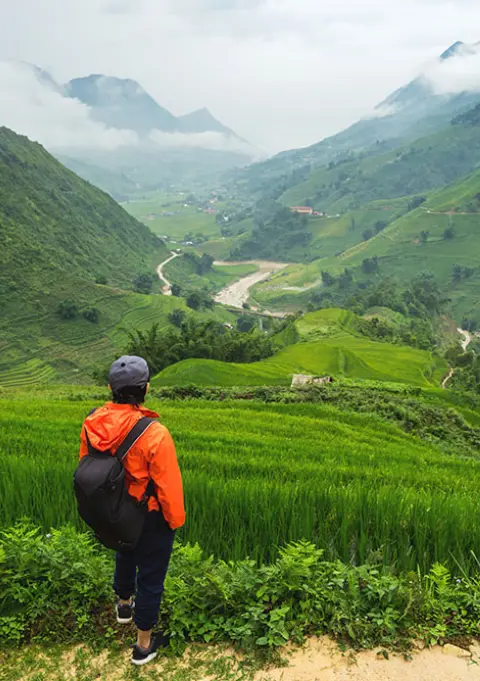
- 4 days 3 night experience
- Moderate to challenging
- Cultural immersion & active adventure
- Mountains, valleys, rice fields & villages
- Private tours – Less Touristic
- Vegan-friendly
The Best Time to Visit the Sapa Rice Fields
Immerse yourself in the beauty of northern Vietnam’s misty mountains and witness the Hmong people’s timeless farming practices by visiting during harvest season when the terraced fields are at their most vibrant. The best time to visit the Sapa rice fields is from September to December when the weather conditions are optimal for trekking and exploring this breathtaking region. During these months, the rice fields transform into a sea of golden hues, making it an ideal time for photographers and nature enthusiasts alike.

The weather in Sapa during December can be chilly with temperatures ranging between 10-15°C (50-59°F), so make sure to pack warm clothing. Despite this, travelers flock to Sapa during this time as it offers clear blue skies and stunning views of rice terraces that stretch far into the horizon. Don’t miss out on experiencing one of Vietnam’s most picturesque landscapes during its prime season! Now that you know when to go, let’s dive into how to get to Sapa.
How to Get to Sapa
Navigating the winding roads to this mountainous region can be a journey in itself, but with some careful planning and a spirit of adventure, getting to Sapa is like embarking on a scenic road trip through time. The most popular way to reach Sapa is by overnight train from Hanoi. Many travel agencies offer packages that include train rides, transportation to and from the station, and accommodation in Sapa.

If you prefer to travel by car or bus, there are several options available as well. You can take a public bus from Hanoi’s My Dinh Bus Station or hire a private car with a driver for a more comfortable ride. Whichever mode of transportation you choose, it is important to plan your travel itinerary carefully and allow enough time for unexpected delays or detours along the way. Once you arrive in Sapa, there are plenty of activities to do that will help you explore the stunning landscapes and rich culture of this hill tribe region.
Sapa 1 Day Tours

- 1 day experience
- Moderate to challenging
- Cultural immersion & active adventure
- Rice fields, valleys & villages
- Private tours
- Vegan-friendly
Sapa 2 Day Tours

- 2 days 1 night experience
- Moderate to challenging
- Cultural immersion & active adventure
- Mountains, valleys, rice fields and villages
- Private tours
- Vegan-friendly
Sapa 3 Day Tours

- 3 days 2 night experience
- Moderate to challenging
- Cultural immersion & active adventure
- Mountains, valley, rice fields & villages
- Private tours
- Vegan-friendly
Sapa 4 Day Tours

- 4 days 3 night experience
- Moderate to challenging
- Cultural immersion & active adventure
- Mountains, valleys, rice fields & villages
- Private tours – Less Touristic
- Vegan-friendly
Activities to Do in Sapa
There’s no shortage of things to do in Sapa, making it the perfect destination for those seeking adventure and cultural experiences. Whether you’re an avid hiker or simply looking to immerse yourself in local traditions, there’s something for everyone. Here are four activities that should not be missed during your visit:
- Hiking trails: Sapa is known for its breathtaking landscapes and hiking trails that wind through lush forests, rice terraces, and traditional villages. From short walks to multi-day treks, there are plenty of options for all levels of fitness and experience.
- Cultural tours: Learn about the unique customs and traditions of local hill tribes by taking a cultural tour. Visit their homes, witness their daily routines, and gain insight into their way of life.
- Explore markets: The bustling marketplaces in Sapa offer a glimpse into the region’s vibrant culture and diverse cuisine. Shop for handmade crafts, try local delicacies, or simply soak up the lively atmosphere.
- Relaxation: After a day filled with adventure and exploration, take some time to unwind at one of Sapa’s many spas or hot springs.
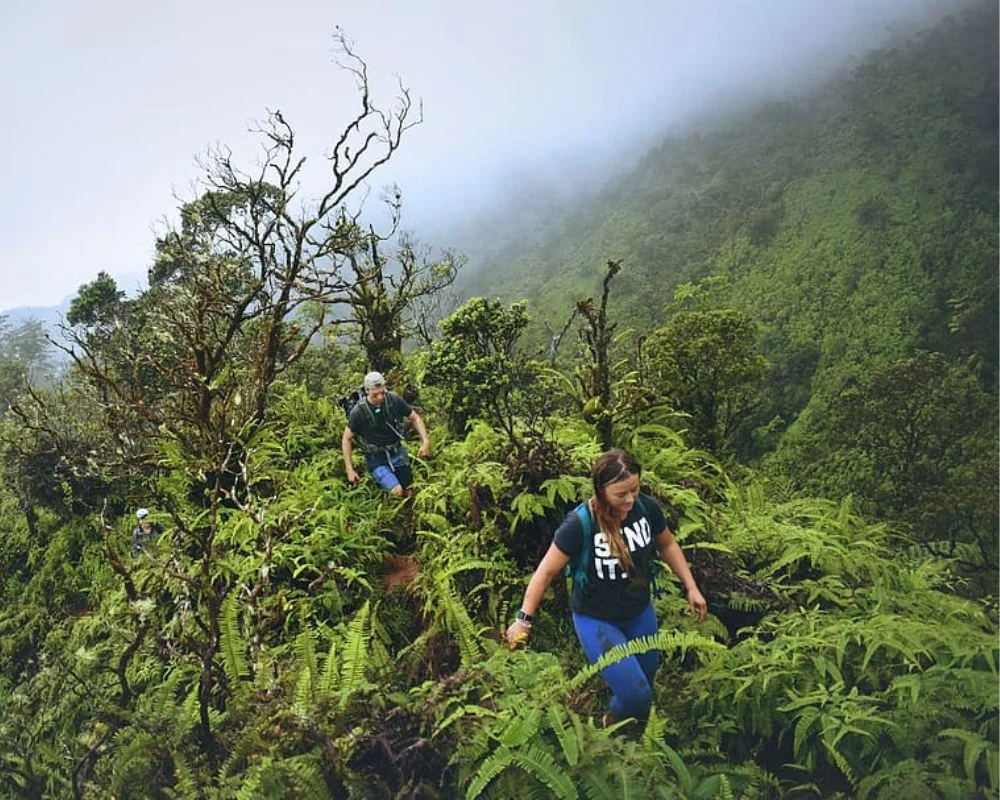
With so much to see and do in Sapa, you’ll want to make sure you have comfortable accommodations and delicious dining options waiting for you after each exciting day.
Accommodations and Dining Options
Now that you’ve explored the various activities to do in Sapa, it’s time to plan your accommodations and dining options. Luckily, Sapa offers a range of accommodation options to suit every budget and preference. From luxury hotels with stunning mountain views to cozy homestays run by local families, there’s no shortage of choices.
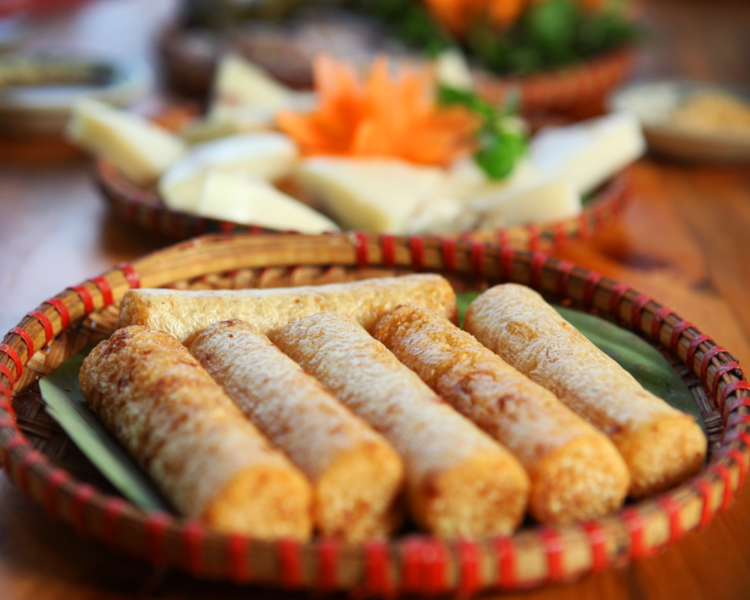
When it comes to dining, Sapa is known for its delicious local cuisine. You can indulge in traditional dishes like thang co (a savory stew made with horse meat) or sip on a hot cup of locally grown tea while taking in the breathtaking scenery. Don’t forget to try some of the region’s fresh produce like bamboo shoots and mushrooms as well! With so many accommodation and dining options available, you’re sure to have an unforgettable experience in Sapa.
As you finalize your plans for exploring the beautiful rice fields of Sapa in December, here are a few tips to keep in mind.
Tips for Visiting the Sapa Rice Fields
To fully enjoy your visit to the stunning scenery of Sapa, don’t forget these tantalizing tips. First and foremost, be sure to bring a good camera or smartphone with you. The Sapa rice fields are truly a photographer’s paradise, with endless opportunities for stunning shots. Be mindful of the lighting – early morning and late afternoon provide the best light for capturing the vibrant green hues of the rice terraces. Don’t be afraid to experiment with different angles and perspectives – crouch down low for a unique viewpoint or zoom in on intricate details.
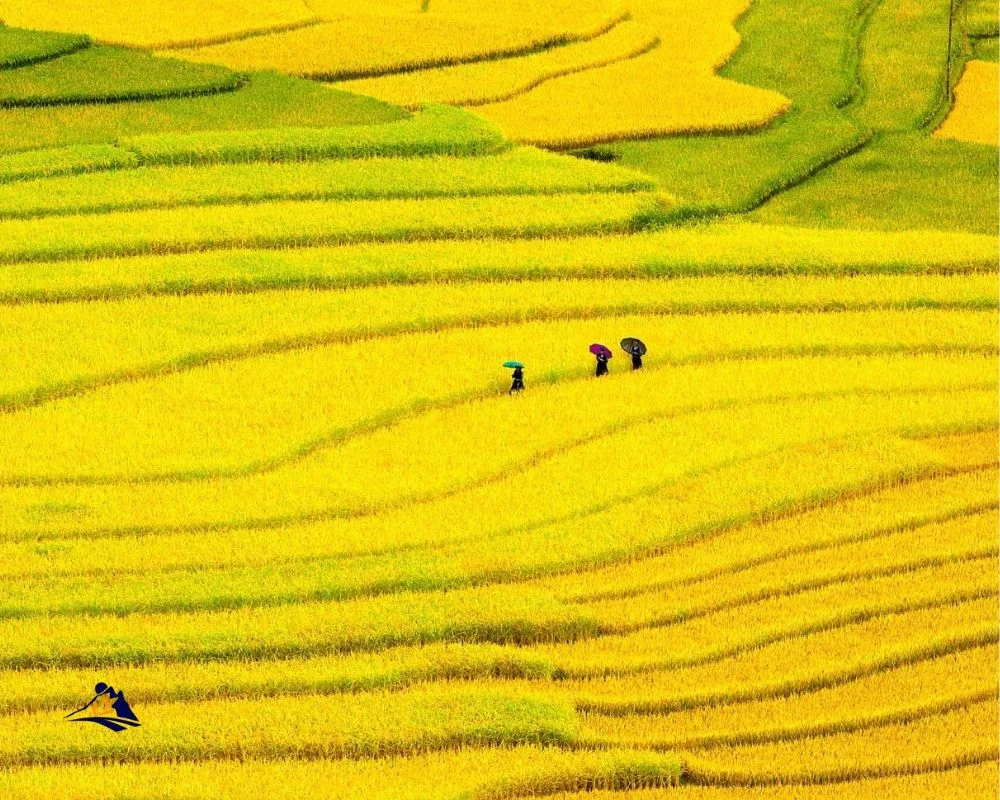
In addition to photography tips, cultural immersion is also an important aspect of visiting the Sapa rice fields. Take time to interact with local communities and learn about their way of life. Consider booking a homestay experience to fully immerse yourself in their culture and customs. You’ll have the opportunity to participate in traditional activities such as farming, cooking, and weaving. Respectful behavior is key – ask permission before taking photos of locals and dress modestly when entering sacred sites such as temples or shrines. By following these tips, you’ll have an unforgettable experience in one of Vietnam’s most beautiful destinations.
Sapa Rice Fields In December Frequently Asked Questions
What is the history of rice cultivation in Vietnam?
Rice cultivation has been a part of Vietnam’s history for over 2,000 years. Vietnamese farmers have developed various rice farming techniques over the years, such as terraced fields in mountainous areas and irrigated paddy fields in lowland areas. However, with the impact of climate change, rice farmers are facing new challenges. Rising temperatures and unpredictable rainfall patterns have led to decreased yields and increased pest infestations. Despite these challenges, many farmers are adapting by using more sustainable practices such as crop rotation and water management systems. As you learn about the history of rice cultivation in Vietnam, it becomes clear that the resilience and adaptability of its people will continue to ensure that this important crop remains a staple in Vietnamese cuisine and culture for generations to come.
What other crops are grown in the Sapa region besides rice?
Did you know that in the Sapa region of Vietnam, terraced agriculture is used to cultivate an array of crops besides rice? Crop diversification has become increasingly popular among farmers in the area. This allows for a more sustainable and diverse food system while also providing economic opportunities for local communities. Some of the other crops grown include corn, sweet potatoes, soybeans, and medicinal herbs. The use of terraced agriculture not only maximizes land use but also prevents soil erosion and water loss on steep hillsides. It’s exciting to see how this traditional farming method continues to evolve and adapt to modern needs while maintaining its cultural significance.
Are there any cultural events or festivals related to rice cultivation in Sapa?
If you’re interested in the cultural significance of rice cultivation in Sapa, you’ll be pleased to know that there are several traditional practices and festivals related to it. Rice is considered the staple food of the region and its cultivation has been an integral part of the local culture for centuries. One such festival is the “Rice Planting Festival” which is celebrated every year during May or June, depending on weather conditions. During this festival, locals dress up in traditional attire and perform various rituals to seek blessings from their deities for a bountiful harvest. Another important event is the “Rice Harvesting Festival” which takes place between September and October each year. This festival celebrates the end of the harvesting season and marks a time when farmers can finally relax after months of hard work. These events are not only important for celebrating tradition but also help in promoting tourism in the region by showcasing local customs and practices.
What are some common challenges faced by rice farmers in Sapa?
As a rice farmer in Sapa, you face an array of challenges that could easily make your job seem impossible. Soil quality is a major issue as the soil in Sapa is often too acidic or too low in nutrients to properly grow healthy crops. Additionally, weather patterns can be unpredictable and harsh, causing droughts or floods which can destroy entire fields of rice. The physical demands of farming are also incredibly taxing on your body, leaving you exhausted at the end of each day. Despite all of these obstacles, however, you persist because you have a deep love for the land and a desire for freedom and independence that cannot be quenched by anything else.
How has tourism impacted the Sapa rice fields and the local community?
If you’re interested in ecotourism benefits and sustainable development, then you may be curious about how tourism has impacted the local community in Sapa. The truth is that responsible tourism can have a positive impact on the area, by providing income for locals and encouraging sustainable development practices. However, it’s important to note that there are also potential downsides to increased tourism, such as increased waste and damage to natural resources. With careful planning and management, however, both tourists and locals can benefit from responsible tourism in Sapa.
Conclusion
So, you’re thinking of visiting the stunning Sapa rice fields in December? You won’t regret it! As we mentioned earlier, the Sapa rice terraces are a sight to behold. With their unique and intricate design, they are considered one of Vietnam’s most beautiful landscapes. But did you know that the Sapa region is home to around 6 ethnic minority groups? These groups include Hmong, Dao, Tay, Giay, Xa Pho, and more. The Hmong people alone make up nearly 50% of Sapa’s population!
It’s fascinating to learn about how these different ethnic groups have contributed to the cultivation and preservation of rice in this region for centuries. The Hmong people especially have a deep connection to their land and have developed traditional farming practices that involve complex irrigation systems and crop rotation techniques. It’s amazing to see how these practices continue to be passed down from generation to generation.
In conclusion, visiting the Sapa rice fields in December offers a unique opportunity to witness not only some of Vietnam’s most breathtaking views but also gain insight into traditional farming practices that have been preserved by local communities for generations. Don’t miss out on this chance to learn about this important facet of Vietnamese culture while taking in some truly unforgettable sights!
Sapa 1 Day Tours

- 1 day experience
- Moderate to challenging
- Cultural immersion & active adventure
- Rice fields, valleys & villages
- Private tours
- Vegan-friendly
Sapa 2 Day Tours

- 2 days 1 night experience
- Moderate to challenging
- Cultural immersion & active adventure
- Mountains, valleys, rice fields and villages
- Private tours
- Vegan-friendly
Sapa 3 Day Tours

- 3 days 2 night experience
- Moderate to challenging
- Cultural immersion & active adventure
- Mountains, valley, rice fields & villages
- Private tours
- Vegan-friendly
Sapa 4 Day Tours

- 4 days 3 night experience
- Moderate to challenging
- Cultural immersion & active adventure
- Mountains, valleys, rice fields & villages
- Private tours – Less Touristic
- Vegan-friendly
